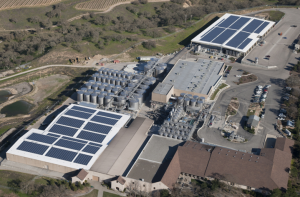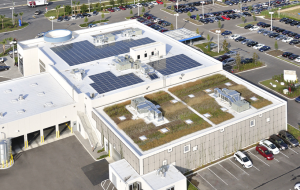Your roof is an asset—an asset that protects your building and everything and everyone in it. So it’s important to get a high quality, environmentally friendly roof system for the lowest annualized cost. There is a new environmentally focused certification for roofing professionals to help building owners make informed decisions about their roofs. The certification
is the RoofPoint Registered Professional (RRP) program.
BACKGROUND
The RRP program adds to the suite of information from the Washington, D.C.-based Center for Environmental Innovation in Roofing (Center) and complements the RoofPoint certification program and its RoofPoint Guideline for Environmentally Innovative Nonresidential Roofing. In addition to the RoofPoint Guideline and certification program, the suite of information
includes the RoofPoint 2012 Energy and Carbon Calculator, the Center/PIMA Roof and Wall Thermal Design Guide, the Center/Spray Foam Coalition Spray Polyurethane Design Guidance document, and guideline documents from the Center’s PV Taskforce about racking and attachment criteria for integration of PV on low- and steep-slope roof systems. The RRP’s focus is to be fluent in the RoofPoint Guideline, however. (More information about RoofPoint and the Center is available in the May/June issue of this magazine, page 34.)

The Meridian Vineyards roof restoration in Paso Robles, Calif., was submitted by D.C. Taylor
Co. and achieved a 17 within RoofPoint, as well as a 2011 RoofPoint Excellence in Design
Award for Excellence in Materials Management.
RRP PROGRAM
The RRP program is intended to provide individual certification for roofing professionals who are designing, specifying, constructing or managing sustainable roof installations certified under the RoofPoint Guideline. The RoofPoint project certification program was started several years ago and has certified hundreds of the most sustainable and environmentally friendly roof installations across the U.S. and North America.
Because many of the sustainable concepts in RoofPoint are likely new to many building owners seeking guidance in the selection of sustainable roofs, the RRP program provides an important link between the ultimate roofing customer—the building owner—and the green-building community, similar to the relationship between the LEED rating system and the LEED AP professional designation.
“RoofPoint Registered Professionals represent a dedicated group of professionals in the roofing industry who make contributions every day to sustainable construction and whose work helps to showcase the critical role roofs play in mitigating the impact buildings have on our environment,” says Center President Craig Silvertooth.
As ambassadors for RoofPoint, RRPs provide services to building owners, facility managers and other building designers interested in achieving the RoofPoint designation for their projects.
CERTIFICATION AND AWARDS
As a building owner, requesting a “RoofPoint roof” in an RFP for a new roof system accelerates the process of ensuring the design and installation of a sustainable roof system. Working directly with RoofPoint Registered Professionals can guarantee the installation of a sustainable roof. RRPs, because they understand the RoofPoint program and process, are capable of self-certifying a new roof as a RoofPoint roof.
A key feature to the RoofPoint program is acknowledgement of the excellent work done by every member of the project team with certificates or awards for the building owner, facility manager, architect or roof consultant, the general contractor, subcontractors and suppliers. Certificates can be awarded to the team as part of a formal or informal presentation.
“I recently had the opportunity to attend a reception sponsored by a charter member of the RRP program in Denver,” notes Jim Hoff, vice president of Research for the Center. “At the reception, we were able to recognize every member of the building team involved in a number of RoofPoint projects for the General Services Administration in Denver. In addition to the GSA’s chief roofing manager, we were able to recognize the roofing contractor, roof system manufacturer, and a number of key service and support organizations that made these award-winning roofing systems possible. RoofPoint and the RRP program really helped to acknowledge everyone involved in these outstanding projects.”

Honda Headquarters,
Clermont, Fla., scored a 22
within RoofPoint for Tecta
America and was recognized with a 2011 RoofPoint Excellence in Design Award, Honorable Mention for Excellence in Water Management.
Furthering the marketing opportunity, a RoofPoint-certified roof is eligible for the Excellence in Design Awards (EDAs). EDAs are given annually to the best RoofPoint projects. The EDA categories include energy, water, material and life-cycle/durability management; global, community, private sector and public sector leadership; excellence in reroofing; and advanced sustainable roofing.
RRP IMPORTANCE
An RRP understands the RoofPoint Guideline and can identify the many ways current roofing systems provide economic value and protect the environment. An RRP will wade through the myriad roof system choices to establish design, installation and maintenance criteria for the selection of sustainable roof systems. An RRP understands how to recognize and validate roof system
selection and reward environmental innovation in roofing. An RRP can help analyze the energy and carbon savings by using the RoofPoint Energy and Carbon Calculator, which helps promote life-cycle costs in lieu of the traditional initial-cost basis for roof system selection.
“For over 20 years, I have worked to promote the value of sustainable roof system design and construction with durable, time-tested materials and construction-detail design, delineated graphically for long-term service life, which is the essence of sustainability,” explains Thomas W. Hutchinson, AIA, FRCI, RRC, principal of Hutchinson Design Group Ltd., Barrington, Ill.; a Roofing editorial advisor; and co-chair of CIB W083 Joint Committee on Roofing Materials and Systems, an international committee on sustainable low-slope roof systems. “The RoofPoint program and the RRP designation help me validate to my clients proven design standards and detailing, as well as help ensure my clients are getting the most durable and sustainable roof systems available.”
If you would like to learn more about RoofPoint and the RRP program, please visit the RoofPoint website, RoofPoint.org. It contains the following detailed materials:
▪▪ Information about the function, structure and content of the RoofPoint Guideline.
▪▪ A comprehensive database of all certified RoofPoint projects in North America.
▪▪ Detailed instructions how to become an RRP, including a free copy of the RRP Program Manual and application form.
▪▪ Free online training videos about RoofPoint, including “Introduction to RoofPoint”, “Scoring RoofPoint Projects” and “Submitting RoofPoint Projects”.
The Center encourages all building owners and facility managers to work with RRPs to obtain appropriate, environmentally friendly roof systems.



Be the first to comment on "RRPs Help Achieve the RoofPoint Designation for Roofing Projects"